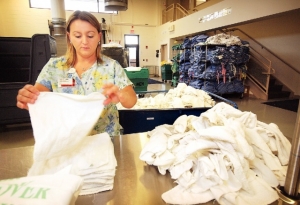Hospital takes on laundry, and adds staff, efficiency
By Phyllis Moore
Published in News on April 6, 2011 1:46 PM

News-Argus/MICHAEL K. DAKOTA
Melinda Byrd folds linens in the new laundry facility at Wayne Memorial Hospital. After deciding that the hospital would be better off doing its laundry in-house, the hospital board chose to build a new state-of-the-art cleaning facility and now is taking in laundry from other hospitals and care facilities.
Wayne Memorial Hospital is taking in laundry.
In addition to providing the service in-house, it has recently added Carteret General Hospital and Wilson Medical Center as well as two nursing care facilities from those areas.
The move has not only increased staff -- from 12 to 25 workers since October -- it is also proven to be energy-efficient in areas of heating and water recycling, officials said.
But when the hospital board first entertained the idea of building the energy plant on-site several years ago, it was with one basic premise.
"The energy plant was almost 40 years old. We needed to upgrade boilers and chillers," explained Joe DePalantino, administrative director of support services. "As we were looking at the future, possible growth of our campus, we knew that our heating and cooling generators ... distribution had to be upgraded to meet the needs of the future.
"Whether or not to build a new laundry was a big consideration. We did some cost analysis. Was it the time for us to hire an outside service to do our linens?"
The research, DePalantino said, showed it to be advantageous for the hospital to keep its laundry service on campus.
"We looked at the future of our laundry, decided to seek over time to provide laundry service," he said.
"We did a due diligence to see if we wanted to do outsource laundry or keep it in-house," added Steve Herron, director of facility services. "We never actively pursued customers until February of last year."
At that time, Allen Smith, who already had 27 years experience in the field, was brought on board as laundry director.
Explaining the setup of the plant behind the hospital, Smith said it is now a "two-shift operation," prompted by the acquisition of contracts from other hospitals and facilities.
"We have pretty much doubled everything," he said. "We started out with 12 (workers), went to 25 since October, and have gone from 1.6 million to almost 6 million pounds (of laundry) a year. We're full, we're at capacity."
Entering the building, it is divided into two basic areas -- the soiled side and the clean side.
Laundry is sorted and loaded into one of three 350-pound washers, or the 135-pound washer for smaller items. There are regulations for everything, from the water temperature used to when and how bleach or other chemicals are added.
Typically, laundries are not air-conditioned. Wayne Memorial's center is unique in that respect, Smith said, as it has a good system creating the flow of cooler air in an otherwise heated environment.
Once the washing cycle is complete, a back door on the washer opens into the "clean side" of the laundry, to prevent contamination between the two areas, he explained, before the next round of sorting.
"Most everything that we wash has to be taken into two 400-pound dryers or the 150-pound dryer," he said. "Most everything is dried (except) our sheets are damp and sent into ironing, which will press them and take the moisture out of them."
Much of the work there is done by hand. There is a small piece folding machine that handles pillow cases, patient gowns, underpads, bath towels and baby blankets and an area where three machines feed into a conveyor, folds the items and counts the stack.
Some of the biggest consumers of electricity are the dryers, so having the thermal recycling capability is advantageous.
"It recycles the heat so we're saving about 50 percent on gas," Herron said. "We have recycled 11 million gallons of water since we started. The energy plant when it started, we dug wells. That was April 2008, the same time the energy plant was completed."
The move has proven cost effective on water bills, he added, as sewage usually makes up the bulk of such an expense.
Wayne Memorial is the first hospital in the state to have the aqua recycling system with a "continuous blowdown" that reheats the water and dumps it back into the boilers, he added.
"We built this with the understanding that we would market it seriously to other hospitals and clients," he said. "It's been very successful for us. The water recycling system takes the water when the washers are done with it, drains into the basement, shakes the lint out of it and then it goes through ultraviolet light, it's fully sterilized and stored here for another load."
Keeping up with which items go where is not too difficult as there is a check and balance system, Smith said. Not only are all orders logged onto a computer, but before the order leaves the building, every container is scanned by bar code to make sure everything lines up.
"There's something called customer-owned goods," he explained. "But that's not the case -- we own all the merchandise, we do it on a rental basis and bill based on what goes out the door.
"We bill everything for the most part by the pound so it's important for me to capture the piece information for my records. They order online. All the customer does is tell us what they want on their delivery."
Trucks run to make deliveries five days a week to Wilson and six days a week to Carteret County, Smith said.
